All about cork boards
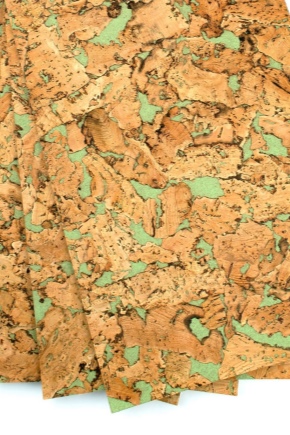
Cork boards have different purposes, they line the floors, revet walls, ceilings. There is a type of office boards that are hung up as an information board; all sorts of stationery invisibles, carnations, hairpins holding sheets of paper with information can easily enter the cork. In the article, we will tell you where this miracle cork comes from, how it is unusual, what properties it has, where and how it is used.

Peculiarities
Cork - a unique material, probably everyone had to see it as an object for corking wine bottles. Today in construction, boards made of cork are used for facing houses and apartments. This material is of natural origin, it is extracted from cork oaks that grow in Africa, Portugal, in some countries of Asia. The bark is removed from a tree at least 25 years old, which goes into production.
The plant itself does not suffer, it is not the living bark that is collected from it, but the one that has dried up and spontaneously began to flake off. It will take up to 10 years for an oak to fully recover, then it will again become a bark donor. The material removed from the oak is left for six months without use, during this period certain processes take place in it.


The collection, stretched over time, affects the final cost of the product.
The peculiarity of cork material lies in its biochemical properties. Essentially, the cortex is made up of large, membrane-covered cells. Each cell contains organic acids such as lignin and suberin, as well as gaseous substances such as oxygen and nitrogen. With the presence of gas in the composition, the material is light, porous and at the same time durable. Cork has many advantages, including the following characteristics.
- Thermal insulation. Thin cork board retains heat better than a sandwich brick wall.
- Soundproofing. The material perfectly protects against extraneous noise.
- Security. An environmentally friendly natural product does not cause allergies and is completely non-toxic.
- Antistatic. The cork does not attract dust, therefore it does not create problems with cleaning.
- Tactile sensations. To the touch - a warm, soft, springy material, which is pleasant to walk on with bare feet.
- Ease of installation. You can cover the floor and walls with a cork board yourself, but if you are not confident in your own abilities, it is better to trust a professional, since the material is not cheap.
- Hides flaws. To install finishing boards, the walls do not need to be perfectly prepared, the cork layer easily hides minor surface imperfections.
- Fire resistance. Despite the fact that cork is made from the bark of trees, it practically does not burn.
- Decorativeness. The cork finish in the interior looks very attractive.

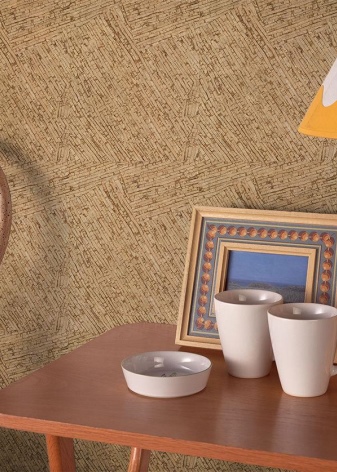
Unfortunately, the material contains some drawbacks, they are as follows.
- Cork is inferior in strength to parquet.
- Reacts to temperature changes by expansion and contraction.
- With some effort, it can be damaged.
- The material is relatively expensive.

Species overview
In production, products are produced from whole bark and its remains, processed into crumbs. After passing heat treatment and pressing, the cork turns into different types of materials. The following products can be found on the construction market.
Solid veneer
Removing the bark from an oak is a painstaking work, it is not always possible to peel off whole layers, but they are highly appreciated, the rest of the material obtained by fragments is used for processing and pressing. One-piece veneer for panels, boards and other finishing material is made from carefully removed large layers.


Agglomerate
The process of removing a whole layer of bark is accompanied by chips, knocked down by small fractions, chips. They are collected and processed into crumbs. The material obtained in this way is used for the manufacture of cork boards, rolls, slabs, it has a budgetary cost and prevails in the construction markets.


Combined
During the production of solid veneer panels, fragments remain, which are combined with small chips. All this is pressed and the material is obtained in the form of homogeneous boards with inserts of large pieces of cork. The cost of the product is superior to agglomerate, but inferior to solid veneer. A glue base is often applied to combined boards, on which a front decorative layer of different textures is planted.
- Oak veneer with clear vinyl protective layer... Such a board becomes stronger than ordinary cork, and its wear resistance increases.

- Veneer made from other wood species, usually expensive exotic species are used. They are protected with a vinyl covering.

- Varnishing... Veneer is glued to the combined cork boards, which is covered with three layers of varnish, obtaining a beautiful decorative shine.
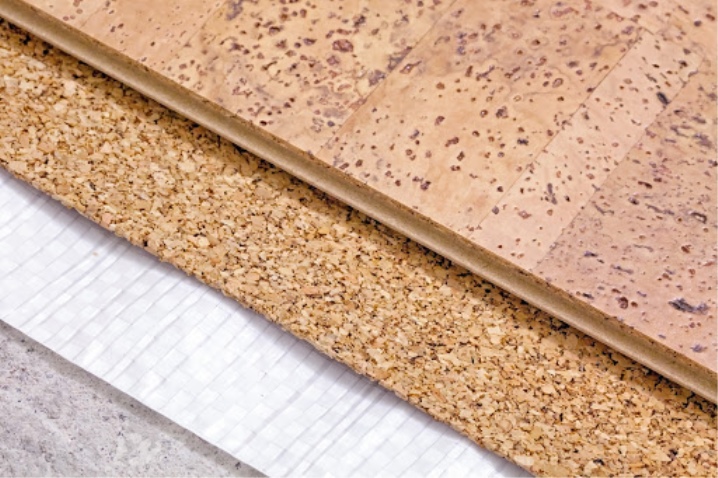
Dimensions (edit)
First, let's talk about cork floorboards. They represent a multi-layer "cake", each layer of which has its own parameters. All layers put together define the overall thickness of the material. It is small, but it does an excellent job with its thermal insulation and sound-absorbing functions. The layers are arranged in order.
- Natural face veneer - 0.8-0.5 mm.
- The pressed cork layer is 2-6 mm.
- HDF with lock - 6.8 mm.

The total thickness of the board may vary. In places of frequent visits, it is better to choose a more durable material, with several layers of pressed cork.
Product dimensions in width and length vary depending on the manufacturer. As for the demonstration cork boards, the dimensions for them are not provided for by GOSTs, and the variety of sizes is due to different purposes.
Bulletin boards in the shop, for information in the office and at the schoolchild's desk above the table may have different parameters. A wide range of cork products goes on sale - from small, 45x60 cm in size, to large ones - 1800-2000 cm.Most often, there are models with dimensions of 60x80 cm, 60x90 cm, 100x50 cm, 90x120 cm, 100x150 cm.
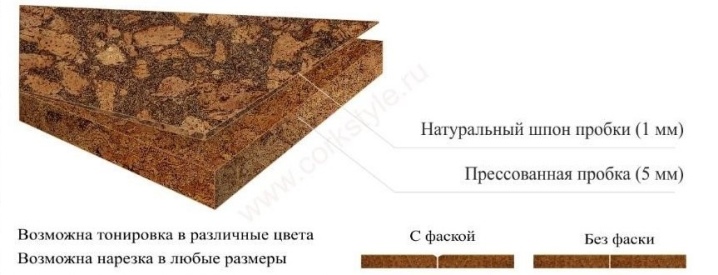
Design options
The cork is organically integrated into the interior. Its natural colors and unusual surface are suitable for many designs. There are products on sale with a top decorative layer, it is distinguished by a variety of texture and pattern. The color of the film can have all shades of black and white, as well as a color palette. We suggest that you familiarize yourself with a selection of photographs reflecting the beauty of interiors decorated with cork oak material.

- The eco-style bedroom walls are covered with warm chocolate finish reminiscent of oak bark.

- The kitchen is completely made of cork. Even the decor is represented by a transparent container filled with bottle caps.

- For children's rooms, artistic techniques of wall decoration are used using natural coatings.

- With the help of cork, you can create beautiful interiors with zoning.

- Spectacular cork floor with colored decorative finish.

Areas of use
Cork boards, like slabs, panels, rolls, are used to decorate rooms. It is installed on walls, floors and ceilings. But there is a board for another purpose - clerical, informational, which is used to demonstrate notes, notes, photographs, announcements and other information.You cannot draw on a cork product, for this there is a marker model, the cork is not intended for stickers, boards with smooth surfaces are produced for them. Let's dwell on products that solve different problems.

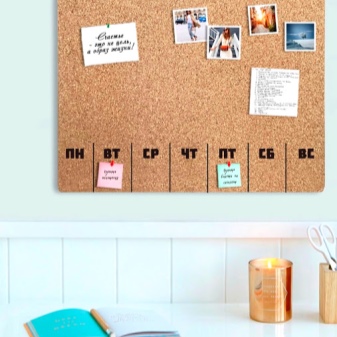
For walls
The walls, decorated with cork, look aesthetically pleasing, non-standard, can be used for eco- and ethno-designs, steampunk, country styles. It is good to decorate children's rooms with such a board, it will be warm and safe in them, since the material is non-toxic, with good natural energy.
Considering the soundproof properties of cork, rooms with the direction of home theaters, dance halls, karaoke, and sound recordings are decorated with products from it. This finish helps to avoid complaints from neighbors about excessive noise.


Unlike rolls, cork boards are used in baths, swimming pools and saunas. It retains heat, tolerates moisture well, does not rot, does not collect mold and mildew.
The wall covering has a wide range of shades - from light sandy to chocolate color, which makes it possible to choose the material for the most demanding designs. Often, porous pressed boards are decorated with veneers of different types of trees, thereby expanding the choice of the necessary coating for a specific interior. We suggest that you familiarize yourself with some non-standard designs using a wall plug.
- Sometimes in cold rooms, cork is used for all interior walls of the house.

- Built-in fragments of decorative material, as well as panels from it, look good in the interior.

- Two wardrobes with cork walls become a warm headboard.

For floor
The floor, in contrast to the walls, is exposed to active loads. For him, cork boards with a greater thickness are chosen. The confidence of the user is given by the material covered with a protective layer of varnish or transparent vinyl. Such a floor is not subject to abrasion and has long-term performance.
A relatively inexpensive type of floor covering contains MDF as a base, the intermediate layer is pressed cork chips, and the top layer is veneer of oak or any other wood. The most expensive material can be considered solid slabs measuring 6x6 m.

Unlike crumbs, they have no chemical compounds, they are a solid natural material. A floor with such a coating looks monolithic and expensive.
All three types of coating are used under a fiberboard base with locks - solid, agglomerate and combined... Lacquer or wax is used as a protective layer.

Examples of interiors with cork coverings will help you appreciate the warm, cozy beauty of the floor.
- The one-piece veneer covering the entire floor surface resembles tree bark.

- The decorative coated keycap is distinguished by its unusual color and structure.

- The sand color of the beautiful veneer floor is taken as the basis for the interior design.

Other
You can decorate the interior not only with cork oak walls, but also with a demonstration wall or table board. Despite its maximum simplicity, postcards, photographs and other objects located on the surface can serve as decoration. In addition to decorative functions, it also has a practical purpose. A lesson schedule, reminders, notes, recipes, favorite sayings and many other useful information are attached to the board with the help of pushpins, needles, pins.
The board itself can look different. The simplest option is a rectangular canvas without a frame.... The thicker it is, the more button punctures it can withstand.
Often, the cork surface is wrapped in a frame made of wood, plastic or metal. Curly boards in the form of a cat, a hedgehog, a cloud are also produced.

The cork has the ability to recover, more than 90% of the surface after piercing takes the previous shape. Thus, it can be used for many years, it all depends on the intensity.The light weight of the product allows you to fix it even on thin partitions. We suggest using examples to familiarize yourself with the variety of demo models.
- Creative people with good imagination do not need to buy a standard board, but make it themselves. To do this, you need to collect bottle caps and lay them on a solid base vertically, horizontally or in any pattern. It remains only to place the work in a frame, and the original product is ready.



- For a children's room, the information board can be supplemented with a narrow shelf or stationery pegs, which can also store notes and notes.

- For younger children, it is better to purchase a curly themed board depicting various objects or animals. The product looks good in the form of a plump cute cat.

Installation secrets
In this chapter, we offer two master classes: first we will tell you how you can assemble an office board yourself, and then we will talk about installing the flooring.
Build a bulletin board
They make a demonstration board on their own for various reasons: someone likes to do everything with their own hands, wants to make a figured product according to their own sketch, or they need a model that matches the general design. To make the simplest rectangular board in a hardware store, you should buy a cork panel of the desired parameter, at least 12 mm thick. If you cannot find a suitable size, you can purchase two thin panels and connect them using special glue purchased from the same store.

If the dimensions do not correspond a little, you can shorten them using a construction knife. To make the structure removable and able to change its location, the cork is glued to a base, for example, plywood or any suitable artificial polymer. The finished product can be decorated with a frame assembled from a baguette.

The board, which needs to be stylized for the interior, can be covered with a fabric that in appearance coincides with the textiles in the room.... So that the buttons do not pull the threads out of the canvas, the fabric is chosen with a rare weave. On the reverse side of the board, two overhead loops are mounted on the top of the baguette. Their location should be invisible from the front of the product. Before you hang the board on the wall, you should make the markings and prepare the fasteners.


Installing a cork floor
To mount the cork board, it is necessary to prepare the surface, to make a perfectly flat screed. The glue should be chosen specifically for the floor. The strongest in fixing is the composition based on polychloroprene rubber. But it has a pungent smell, you will have to work in a respirator, in a well-ventilated area. In addition to glue, a varnish intended for a cork surface is purchased in advance ("any" will not work). Cork boards cannot be installed immediately after delivery, they must be opened and left for 1-3 days (the accompanying instructions indicate the adaptation time).
While the material is being adapted, it is sorted. Due to the sensitivity of the natural product, it may have some flaws. Completely whole boards are laid aside, they will be the majority. Then, two piles are formed: slabs with slight damage go into one, and slabs with noticeable defects in the other. From the first laying, the boards are mounted in places where they are less noticeable - under furniture, near the plinth.


The material from the second laying will be used for cutting, it will be needed where tile fragments are needed.
The assembly of the cork board takes place in the following order.
- The room should be divided in half lengthwise and installation should begin from this line. The installation of the tiles is carried out with a shift of the seams (staggered). The offset step is ½ or 1/3 of the board, it is not changed during all laying work. After trying on the tiles, glue is applied to the screed.
- The back surface of the cork material is glued with a velor-based roller and left for half an hour or for the time specified in the instructions, each composition may have its own.When working with glue, you need to try not to get it on the front surface of the material, and if this happens, immediately remove it with a special solvent.
- Next, the board is glued to the floor and rolled over it with a rubber roller to improve adhesion. Installation should take place according to the markings made according to the diagram. You can correct it with fresh glue, it will no longer be possible to dismantle it.
- A 5 mm gap should be left between the wall and the cork as the material expands to temperature fluctuations. In the last row, tiles may need to be shortened. It is necessary to cut with a sharp construction knife, placing a hard surface under the material.
- After installing the cork cover on one half of the room, proceed to the installation of the second half.
- At the end of the work, the entire floor surface should be rolled with a rubber roller.
- After the glue dries, the floor surface is cleaned of dust and any debris, preparing it for varnishing.
- The entire surface is covered with varnish 3-4 times. Each coat must dry thoroughly before the next coat is applied.
- After the floor is completely dry, proceed to the installation of the skirting board. It is better to immediately purchase varnished products so as not to varnish them yourself.

Whatever you choose as a cork finish - floor, walls or ceiling, the room will become cozy and acquire a special charm... But it must be remembered that the material has almost as many disadvantages as there are advantages. Therefore, you should weigh the pros and cons before proceeding with the repair.
For the installation of a cork floor, see the video.













The comment was sent successfully.